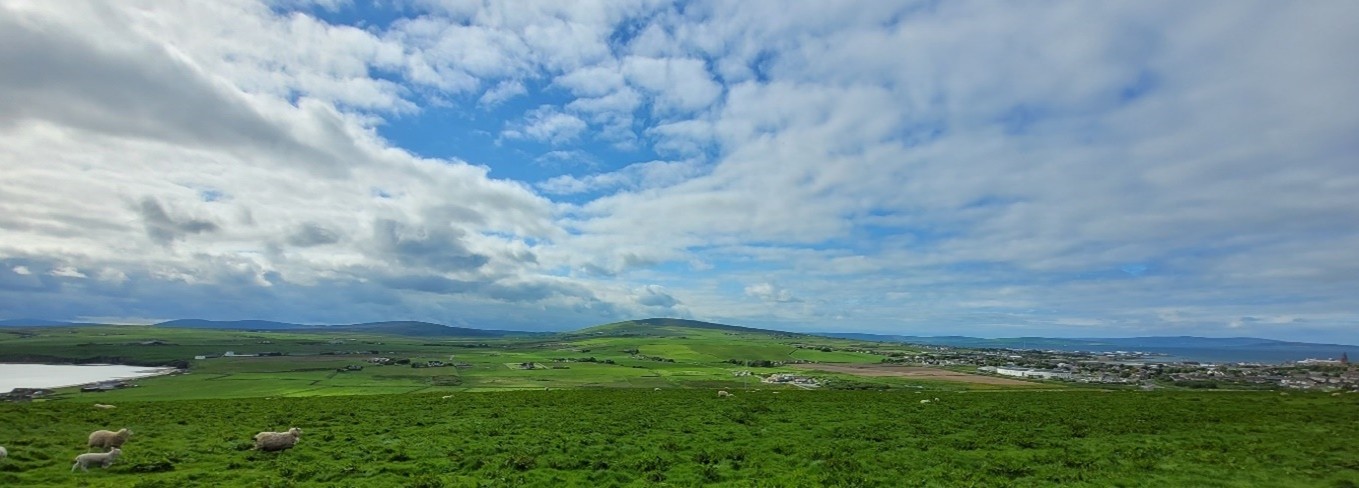
09/03/2025, by aezcr
Scapa…part one…
Skálpeið is mentioned several times in the Saga of the Earls of Orkney and we find the place-name ‘Scapa’ applied to a number of places in Orkney: Scapa Flow and Scapa Bay in the sea, and on land at two farms (Upper and Nether Scapa), Scapa House, not to mention the modern Scapa Distillery near Lingro Burn and the Iron Age Lingro Broch.
Scapa Bay refers to part of the famous body of water that is Scapa Flow renowned for the shelter it has provided for shipping, the scuttling of the WWI German fleet, and for the Churchill barriers.
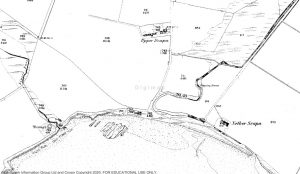
Detail from the 1880 OS showing the shoreline of Scapa Bay, the location of Lingro Broch (near to which Scapa House was and Scapa Distillery is) and Upper and Nether Scapa.
The name is usually interpreted as ‘ship-isthmus’, made up of ON skalpr and eið. While ON skalpr, as previously discussed in relation to the place-name Knarston, may have been a poetic term for a ship and whilst it is tempting to see this place-name as encompassing a boat-word, the more prosaic interpretation of skalpr ‘scabbard’ is perhaps more likely, referring to the distinctive shape of the bay. Indeed, while ONP notes that the term has been used ‘of a ship’ the majority of the occurrences cited refer to either a scabbard or a sword-sheath.

View of Scapa Bay and the Knarston (far side of the bay) area, from Thule.
Marwick’s other thought about the specific element is equally apt. He points out that, etymologically, skalpr also had the sense of ‘something cleft in two’ and so it could refer to the ‘long hollow or depression in the terrain’ which exists between Scapa and Kirkwall, with the name being understood as ‘long valley isthmus’ or ‘as the isthmus cleaving Orkney Mainland in two’ (Marwick, Farm Names, p. 100).
The second element eið is ‘isthmus, narrow neck of land’ and appears to apply the narrow neck of land extending between Scapa Bay and Kirkwall.
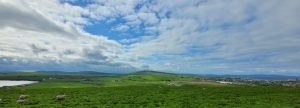
View of the low-lying narrow neck of land between Scapa Bay (left) and Kirkwall (right).
That the eið refers to this neck of land is supported by the saga evidence in which the Scapa side of the landscape feature is used as a point at which to disembark to make one’s way, with ease, across to Kirkwall.
‘It happened one day in Kirkwall that Earl Rǫgnvaldr had an assembly with the householders. And while people were at the assembly, it was seen that nine armed men were walking from Scapa to the assembly. And when they arrived at the assembly, they recognised Sveinn Ásleifarson, and people were curious what news he might have. Sveinn had sailed from the south to Scapa and left the ship there, and then they walked to Kirkwall.’ (Chapter 76).
And,
‘Þorbjǫrn went secretly to the Orkneys on a small ship with thirty men and landed in Scapa; he went to Kirkwall with three men. He ran alone into a tavern that evening in which Þórarinn was drinking.’ (Chapter 100).
The place-name spellings are largely consistent throughout the saga and they seem to concur with the interpretations discussed above:
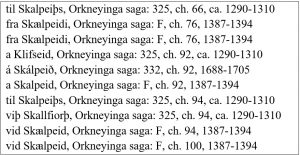
Table showing the earliest spellings of Scapa in the saga.
Notably, there are occasions in the AM 325 I 4to manuscript (ca. 1290–1310) in which ‘alternative’ names are used for what is understood, in saga translations, to be the same place. In chapter 66 we have til Skalpeiþs, in chapter 92 a Klifseid, and in chapter 94 til Skalpeiþs and viþ Skallfiorþ. In later manuscripts in which the same chapters (92 and 94) survive there is no variation from the skalpr and eið elements.
To find out what we make of these variations – look out for ‘Scapa… part 2’!
But to conclude part one, the name Scapa describes a significant saga waterway and isthmus much used and distinctive in appearance. The beachy shore at Scapa Bay with its close proximity to Kirkwall across a narrow neck of land with a watercourse (visible on Mackenzie’s 1750 map below) is striking. The saga attests to it being a recognisable landing-site used for expeditious access to Kirkwall for assemblies and social gatherings, and for trade (as evidenced by the mention of cargo ships). The survival of the Scapa name has continued and has become applicable to several places and features. Once denoting a distinctive and important isthmus and inlet, the name came to be applied to that large area encompassing not only the bay, but also the flow, as well as farms, houses, and now the distillery.
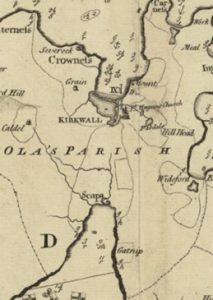
Detail from MacKenzie’s Map of Orkney (1750), showing the location of Scapa, with its long narrow bay reaching into mainland Orkney towards Kirkwall. Reproduced with the permission of the National Library of Scotland.
Corinna Rayner and Matthew Blake
Further Reading
Bates, Martin, Richard Bates, Barbara Crawford, and Alexandra Sanmark, ‘The Norse Waterways of West Mainland Orkney, Scotland’, Journal of wetland archaeology, 20 (1–2) 2020, pp. 25–42.
Cleasby, Richard and Gudbrand Vigfusson, An Icelandic-English Dictionary (Oxford: Clarendon Press, 1874).
Crawford, B. E. 2006, ‘Huseby, Harray and Knarston in the West Mainland of Orkney: Toponymic Indicators of Administrative Authority?’, in Names through the Looking-Glass, ed. by P. Gammeltoft and B. Jørgensen (Copenhagen: C. A. Reitzels Forlag A/S, 2006), pp. 21–44.
Historic Environment Scotland, Canmore – National Record of the Historic Environment, https://canmore.org.uk/
MacKenzie, Murdoch (Senior), ‘Pomona or main-land’ (London: Printed for the author, Imprint 1750) https://maps.nls.uk/coasts/chart/4143
Marwick, Hugh, Orkney Farm Names (Kirkwall: W. R. Mackintosh, 1952).
Rygh, O., ‘Gaardnavne i Buskerud Amt’, Norske Gaardnavne, 6, (Kristiania: W. C. Fabritius & Sonner A/S, 1907)
Rygh, O., ‘Gaardnavne i Buskerud Amt’, Norske Gaardnavne, 5, (Kristiania: W. C. Fabritius & Sonner A/S, 1909)
Sandnes, Berit, From Starafjall to Starling Hill: An investigation of the formation and development of Old Norse place-names in Orkney (Scottish Place-Name Society, 2010).
Sigurðardóttir, Aldís et al. (eds), Dictionary of Old Norse Prose (ONP) (Copenhagen: University of Copenhagen, 1989‒2021) https://onp.ku.dk/onp/onp.php.
Thomson, William P. L., Lord Henry Sinclair’s 1492 Rental of Orkney, (Kirkwall: The Orkney Press, 1996).
Thomson, William P. L., Orkney Land and People, (Kirkwall: Kirkwall Press, 2008).
No comments yet, fill out a comment to be the first

Leave a Reply